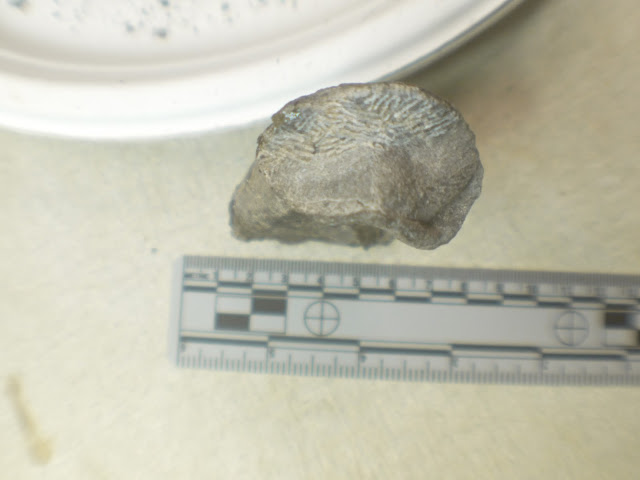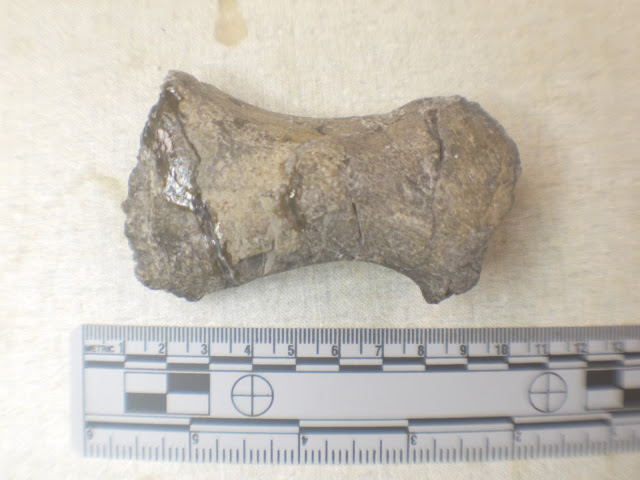I've been working on a great piece of the upper jaw of our Thalattosaurs. I just got it finished today - still have to scan it before it goes to Alaska. It has two wonderful new things to teach us that I haven't understood before. Here is the inside (lingual) side of the jaw.
And here is the outside (Bucal). It is 14.8cm long (almost 6 inches).

The first item is that this upper jaw, containing part of the hard palate, has a large vomeronasal pit. This pit is located at the outside edge of the palate where it hooks to the tooth row. These pits are smelling organs used in conjunction with the animal's tongue. Think of a snake or a monitor lizard - they put out their tongue, wave it around a bit, then retract it. Out in the air the surface of the tongue absorbs molecules that we refer to as 'odors'. Upon retraction the tongue tip is inserted into the vomeronasal pit, where the molecules come off the tongue and attache to smell sensor cells on the walls of the pit. In this way some reptiles have an accurate sense of smell.


Why is this important? - because these pits have not been identified in this type of animal before! Preservation of other hard palates hasn't been good enough to see them clearly. This pit is quite deep, over 1 cm and almost pierces through the top of the palate. The bone at the top is less than 1 mm thick. I think this has major implications for the lifestyle of these animals. Smelling your food in the water, perhaps, along with excellent vision to hunt them down in deep water?

The second 'Pits' in this essay are concerning the teeth. There are 6 major teeth in this jaw. All of these teeth have been broken off at the bone line. They all show extensive abscesses through the dentine down into the jawbone! This can tell us much about the teeth of these animals - they are very different than lizard or dinosaur teeth and much more like mammal teeth.
Here is the biggest tooth - it is about 9mm across. The most prominent ring is the hard enamel, which is the hardest part of the tooth. The enamel is broken exposing the dentine inside the tooth, where mammals have their blood vessels and nerves. This is what is removed by the dentist when you get a 'root canal'!
This did not happen at death - if the tooth was broken at death, the dentine would still be filling the inside of the tooth and it would be relatively flat-topped. Instead, we have a pit where the dentine rotted away before death.
Here are two other teeth. As before, there are very deep pits on the inside of the tooth inside the ring of enamel. One of these pite is only about 2mm diameter but over 8mm deep! And there is still matrix at the bottom - I can't see to prep it out deeper.
Here is the most severe pit of all. You see the two rings of abscessed teeth - in between there is a hole where half the tooth enamel is still present, but the entire other half of the tooth and the surrounding bone is missing.
This side view shows how much bone is missing - the hole is about 12mm long, 6mm wide and about 8mm deep. This animal was probably hurting!
Older dental abscesses are known, including one from a Permian animal.
http://blog.everythingdinosaur.co.uk/blog/_archives/2011/04/20/4799483.html The authors of that paper concluded that these were true real-life dental problems and that their animal did not frequently shed it's teeth. Dental abscesses are unheard of in modern lizards, and not very common among dinosaurs since diseased teeth are merely shed and not allowed to decay. Perhaps Bernie's type of animals did not shed their teeth either?
Sometimes life is the Pits.
Sincerely, Greg Carr

















